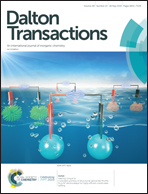POM-FLPs: [Mo IV3]n-polyoxometalate bifunctional catalysis by [Mo IV3]n–Om Lewis pairs frustrated by triangular MoIV–MoIV bonds†
Abstract
Lewis acid and Lewis base pairs combined in a single system are emerging as one of the most active frontier areas in bifunctional catalysis. To serve as efficient Lewis acid and Lewis base bifunctional catalysts, more reduced MoIVn-polyoxometalates having multiple MoIV–(μ2-O) Lewis pairs are necessary. The new mixed solvent pyridine/DMF/H2O and heterometal oxide (GeO2) have been introduced into the solvothermal partial oxidation system of [Mo3O2(O2CCH3)6(H2O)3]ZnCl4 to yield two novel [MoIV3]n-POM family members, H4[Mo@MoIV6MoV6MoVI8O54(OH)4py6] ({Mo@Mo20}-1) and [Ge@MoIV6MoVI10Zn0.5Ge1.5O47.5(H2O)0.5py6] ({Ge@Mo16Ge1.5Zn0.5}-2), providing two new important routes to extend the POM-FLP system and allowing for a systematic investigation into their reasonable syntheses, diverse molecular and electronic structures, and their influence on the catalytic efficiency. The POM-FLP system exhibits excellent selectivity (>97%) and structure-dependent conversion dominated by the HOMO MoIV percentage, and the number and linkage of [MoIV3]n–(μ2-O)m FLPs in the hydrazine transfer hydrogenation reduction of nitrobenzene to aniline, which is helpful to achieve optimal catalysis performance of the POM-FLP system in transfer hydrogenation or other catalysis reactions that are yet to be developed.
![Graphical abstract: POM-FLPs: [MoIV3]n-polyoxometalate bifunctional catalysis by [MoIV3]n–Om Lewis pairs frustrated by triangular MoIV–MoIV bonds](/en/Image/Get?imageInfo.ImageType=GA&imageInfo.ImageIdentifier.ManuscriptID=C9DT00983C&imageInfo.ImageIdentifier.Year=2019)


 Please wait while we load your content...
Please wait while we load your content...